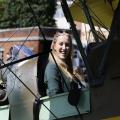A CHAPEL in Weston? Yes, one of the earliest in the area, built just 100 years after John Wesley first began preaching.
How did such a small village come to have a purpose built chapel?
As early as 1682 Weston was recorded as having a family of nonconformists but it wasn’t until 1818 that a licence was issued to allow the use of a property as a place of worship for Protestant dissenters.
John East had returned to the village from Buckinghamshire fired by Methodism and along with a relative, William Brain, began meetings in William’s home.
William was threatened by both the Lord of the manor and the vicar that he would lose his home if the meetings persisted.
They found another house to hold their meetings and by 1834 they were recognised as a group of Methodist worshippers.
However, as their numbers grew, they sometimes found that it was not possible to use the premises and, at a time of personal financial troubles, the owner agreed to sell the garden associated with this cottage, for £20, to the Methodists.
The story goes that he came into money just a few weeks later and would not then have sold the ground.
It was one of the very few pieces of land within the village not owned by the Manor, so was doubly precious.
A further 6ft 6ins of land was purchased for 15 shillings and so for £20 15s the Methodists now had a piece of land on which to build a chapel.
Whereas their meetings had previously been threatened the Chapel-goers could now be independent of the establishment. They just needed to build the chapel.
The building was ‘…by their own hands…’ and took some time to finance.
The men gave their labour for free and farmers lent wagons and horses for the hauling of stone and wood but the cost of materials had to be covered.
One method of fund raising involved ‘seat rent’ where a man and his wife would pay two shillings and sixpence per quarter for the privilege of sitting in front of a ticket on their pew.
At one time there were 50 such seats and only 32 ‘free’ ones. Ten shillings a year was a considerable undertaking for a man who was only earning about 10 shillings a week.
The building was first used in 1838 but it took 36 years to pay off the debt.
There was a stove, wooden pews, a communion table, lectern and panelling round the walls. Music was later provided by a harmonium, with electricity, after 1930, provided lights and heating.
In addition to two services on Sunday, two or three during the week and a Sunday School there were fellowship meetings when a young boy helped the group study as they, themselves, could not read well enough (or at all).
There was also a Band of Hope who had an annual picnic and the Sunday School held a summer outing.
Many children in the village attended both the Chapel and Church Sunday Schools so as to be eligible for the two summer outings.
In 1938 it was recorded that the Sunday School children helped raise the £10 needed for extra land, used eventually, in 1972, for a small room with a toilet and washbasin.
The anniversary of the opening of the Chapel was celebrated each year with a tea and special services – recitations, plays and solo singing took pride of place at these events.
Numbers continued to grow with the 1851 census of attendance at places of worship recording 80 adults in the afternoon and 100 in the evening.
An exhibition relating to the history of the building was staged on the 150th anniversary. At that time the harmonium was still being played by the 92-year-old daughter of the young boy who had helped the early men by reading to them from the Bible.
In the final years of the chapel many still attended the Anniversary service but numbers at weekly services fell until there were just four. When these four found that extensive work was required to deal with dry and wet rot the decision to close and sell the property was taken.
And so the chapel closed after 155 years, in 1993.
It was bought by the then owners of a neighbouring property and has remained a part of that private home since.







Comments: Our rules
We want our comments to be a lively and valuable part of our community - a place where readers can debate and engage with the most important local issues. The ability to comment on our stories is a privilege, not a right, however, and that privilege may be withdrawn if it is abused or misused.
Please report any comments that break our rules.
Read the rules here